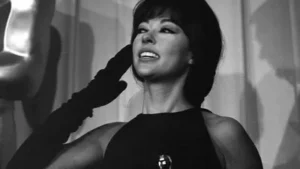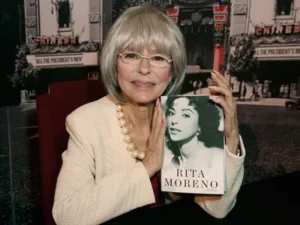Rita Moreno
American dancer, singer, and actress
Also known as: Rosa Dolores Alverio, Rosita Dolores Alverio
Rita Moreno
Rita Moreno Rita Moreno at a book signing for her memoir, 2013.
Rita Moreno (born December 11, 1931, Humacao, Puerto Rico) is a Puerto Rican-born American actress, dancer, and singer who accomplished the rare feat of winning the four major North American entertainment awards (EGOT): Emmy (1977, 1978), Grammy (1972), Oscar (1962), and Tony (1975). She was also the first Hispanic woman to receive an Oscar (Academy Award).
After her parents divorced, Alverio moved (1935) to New York City with her mother, who eventually remarried. She later began using her stepfather’s surname, Moreno. As a youth, she took dance lessons, and she later dubbed voices for American child stars in films released to Spanish-speaking countries. In 1945, at age 13, she made her Broadway debut in Skydrift. Her first big-screen appearance was in So Young, So Bad (1950). She was credited as Rosita Moreno, but soon thereafter she took the first name Rita.
Quick Facts
In full: Rosita Dolores Alverio
Born: December 11, 1931, Humacao, Puerto Rico (age 92)
Awards And Honors: Kennedy Center Honors (2015) Presidential Medal of Freedom (2004) Emmy Award (1978) Emmy Award (1977) Tony Awards (1975) Grammy Award (1972) Academy Award (1962) Academy Award (1962): Actress in a Supporting Role Emmy Award (2008): Televisionary Award Emmy Award (1978): Outstanding Lead Actress for a Single Appearance in a Drama or Comedy Series Emmy Award (1977): Outstanding Continuing or Single Performance by a Supporting Actress in Variety or Music Golden Globe Award (1962): Best Supporting Actress in a Motion Picture Grammy Award (1973): Best Recording for Children Tony Award (1975): Best Featured Actress in a Play
Rita Moreno
1 of 2
Rita MorenoRita Moreno after winning the Academy Award for best supporting actress, 1962.
Rita Moreno
2 of 2
Rita MorenoRita Moreno in West Side Story (1961).
Although Moreno subsequently appeared in several notable films—including the musicals Singin’ in the Rain (1952) and The King and I (1956), playing a starlet and a slave, respectively—her early career was hampered by studios wanting to cast her in stereotypical ethnic roles or as a sexpot. Partly because of professional frustrations—though largely because of a tumultuous relationship with Marlon Brando—she attempted suicide in 1961. That year, however, Moreno received critical acclaim as the fiery and cynical Anita in West Side Story. For her performance—which highlighted her energetic dancing—Moreno won an Academy Award for best supporting actress. (Although she was a singer, her singing voice was dubbed in the movie.) The musical drama was named best picture. Despite the success, Moreno continued to struggle for good roles, and her film work was limited. Later movies included Summer and Smoke (1961), Carnal Knowledge (1971), and Slums of Beverly Hills (1998). In 2021 she appeared in Steven Spielberg’s acclaimed remake of West Side Story, and two years later she joined an all-star cast—that included Jane Fonda, Sally Field, and Lily Tomlin—in 80 for Brady, a comedy about a group of friends whose love for the New England Patriots and star quarterback Tom Brady leads to a raucous Super Bowl weekend.
Empty movie theater and blank screen (theatre, motion pictures, cinema).
Britannica Quiz
Oscar-Worthy Movie Trivia
In 1964 Moreno returned to Broadway, appearing in The Sign in Sidney Brustein’s Window. She continued to occasionally perform on the stage, and in 1975 she won a Tony for her portrayal of Googie Gomez in The Ritz. She reprised the comedic role for the 1976 film adaptation. Her other notable stage work included The Odd Couple (1985–86), a revival of the Neil Simon play but featuring female leads. In 2011 she starred in the critically acclaimed Rita Moreno: Life Without Makeup, which was staged in California and showcased her irrepressible nature.
Moreno also frequently appeared on television. From 1971 to 1977 she starred in the children’s educational series The Electric Company, where she became noted for the catchphrase “Hey, you guys!” In 1972 she received a Grammy for her work on the show’s album. An appearance on The Muppet Show earned her an Emmy in 1977, and with that award she became the second woman and third person to win an EGOT; earlier that year Helen Hayes had accomplished the feat. In 1978 Moreno claimed her second Emmy, for her work on The Rockford Files. She later appeared as a nun/counselor in the prison drama Oz (1997–2003), and she had guest roles in numerous series, including The Golden Girls, Miami Vice, Murphy Brown, and Ugly Betty. Moreno also provided the voice of the title character in the PBS series Where on Earth Is Carmen Sandiego? She later appeared as the matriarch of a Cuban American family in One Day at a Time (2017–20), a remake of Norman Lear’s 1970s sitcom of the same name; the series originally aired on Netflix, but after three seasons it moved to Pop TV for a short run.
Moreno’s other notable awards included the Presidential Medal of Freedom (2004), and in 2015 she was named a recipient of a Kennedy Center Honor. She published an eponymous memoir in 2013. Rita Moreno: Just a Girl Who Decided to Go for It (2021) is a documentary about her life and career.
https://biobest.com.ng/althea-gibson-bi…ionships-in-1950/
Who Was Althea Gibson?
Althea Gibson developed a love of tennis at an early age, but in the 1940s and ’50s, most tournaments were closed to African Americans. Gibson kept playing (and winning) until her skills could no longer be denied, and in 1951, she became the first African American to play at Wimbledon. Gibson won the women’s singles and doubles at Wimbledon in 1957 and won the U.S. Open in 1958.
Early Life and Career
Althea Neale Gibson was born on August 25, 1927, in Silver, South Carolina. Gibson blazed a new trail in the sport of tennis, winning some of the sport’s biggest titles in the 1950s, and broke racial barriers in professional golf as well.
At a young age, Gibson moved with her family to Harlem, a neighborhood in the borough of New York City. Gibson’s life at this time had its hardships. Her family struggled to make ends meet, living on public assistance for a time, and Gibson struggled in the classroom, often skipping school altogether. However, Gibson loved to play sports — especially paddle tennis — and she soon made a name for herself as a local paddle tennis champion. Her skills were eventually noticed by musician Buddy Walker, who invited her to play tennis on local courts.
After winning several tournaments hosted by the local recreation department, Gibson was introduced to the Harlem River Tennis Courts in 1941. Incredibly, just a year after picking up a racket for the first time, she won a local tournament sponsored by the American Tennis Association, an African American organization established to promote and sponsor tournaments for Black players. She picked up two more ATA titles in 1944 and 1945. Then, after losing one title in 1946, Gibson won 10 straight championships from 1947 to 1956. Amidst this winning streak, she made history as the first African American tennis player to compete at both the U.S. National Championships (1950) and Wimbledon (1951).
Later Years and Death
Following her retirement, in 1971, Gibson was inducted into the International Tennis Hall of Fame. She stayed connected to sports, however, through a number of service positions. Beginning in 1975, she served 10 years as commissioner of athletics for New Jersey State. She was also a member of the governor’s council on physical fitness.
But just as her early childhood had been, Gibson’s last few years were dominated by hardship. She nearly went bankrupt before former tennis great Billie Jean King and others stepped in to help her out. Her health, too, went into decline. She suffered a stroke and developed serious heart problems. On September 28, 2003, Gibson died of respiratory failure in East Orange,New Jersey.




